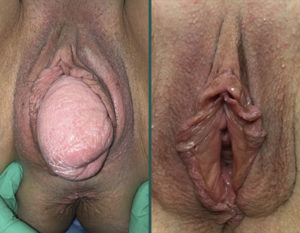What Does A Prolapsed Uterus Look Like?
Because there are several types of pelvic organ prolapse, as well as varying degrees of severity, it can be difficult to know if symptoms you are experiencing are related to a specific type of prolapse. While we always advise against self-diagnosing, (especially considering that we offer free consultations), there are indicators of prolapse that you can look out for.
First off, it is important to understand that aside from the uterus (uterine prolapse), the bladder (cystocele), small intestine (enterocele), and rectum (rectocele) can also protrude into the vaginal cavity as the muscles in the pelvic floor weaken over time, and it is not uncommon for several organs to prolapse at once.
Secondly, the severity of pelvic organ prolapse is rated in stages of 1 to 4, based on the amount of descent present. Minimal dropping of the prolapsing organ is considered Stage 1 prolapse, whereas a Stage 4 prolapse means the prolapsed organ has completely dropped into the vagina. Stage 1 prolapse is often asymptomatic, making it hard to detect. Once the prolapse has progressed to a certain point, vaginal or robotic prolapse surgery can be performed. The exact procedure(s) will depend on the individual’s unique symptoms and condition.
Stage I: the cervix of the uterus has begun to descend, but is still in the vagina.
Stage II: the cervix of the uterus has descended to the vaginal opening.
Stage III: the cervix of the uterus has begun to breach through the vaginal opening.
Stage IV: the cervix of the uterus has fully descended through the vaginal opening.
By the time pelvic organ prolapse reaches Stage 3 and Stage 4, patients typically begin to experience some of the following symptoms: urinary tract infections, urinary retention (incomplete bladder emptying), pelvic heaviness/pressure, constipation/incomplete defecation, painful intercourse and/or lower back pain.. On the left-hand side of the image below, you can see a patient with complete pelvic organ prolapse of the uterus, bladder, and rectum (Stage 4 prolapse). On the right side is the same patient following a trans-vaginal hysterectomy and vaginal prolapse repair (she underwent a da Vinci sacrocolpoperineopexy).
Depending on the level of laxity and weakening of these ligaments and muscles, there are a number of treatments that women can choose from in order to alleviate these symptoms. Vaginal tightening creams can help feelings of “looseness” and laxity that are often associated with early stages of uterine prolapse. Some women who come in for consultations for vaginal rejuvenation find that they are in the early stages of uterine prolapse. There are a number of ways to treat symptomatic uterine prolapse.
Some women choose to treat uterine prolapse with a pessary. A pessary is a vaginal support device used to elevate the prolapse by occupying space in the vagina. A pessary is typically used in women who are not candidates for surgery due to age or poor health. Surgery is elective and is done to relieve symptoms and restore the anatomy of the vagina. Symptoms of prolapse do not decrease without treatment. Surgery to treat uterine prolapse may include supracervical or complete hysterectomy, often in combination with da Vinci sacrocolpopexy or uterosacral colpopexy.

If you believe that you may be experiencing symptoms of pelvic organ prolapse, contact Austin Urogynecology today to schedule a free consultation.
Got questions? Need an appointment? We’re here to help!